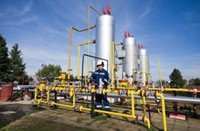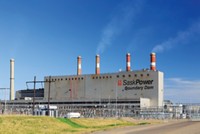Advertisement
Grab your lab coat. Let's get started
Welcome!
Welcome!
Create an account below to get 6 C&EN articles per month, receive newsletters and more - all free.
It seems this is your first time logging in online. Please enter the following information to continue.
As an ACS member you automatically get access to this site. All we need is few more details to create your reading experience.
Not you? Sign in with a different account.
Not you? Sign in with a different account.
ERROR 1
ERROR 1
ERROR 2
ERROR 2
ERROR 2
ERROR 2
ERROR 2
Password and Confirm password must match.
If you have an ACS member number, please enter it here so we can link this account to your membership. (optional)
ERROR 2
ACS values your privacy. By submitting your information, you are gaining access to C&EN and subscribing to our weekly newsletter. We use the information you provide to make your reading experience better, and we will never sell your data to third party members.
Environment
Cement could be a helpful carbon sink
Model suggests cement reacting with CO₂ can offset part of the emissions from its production
by Michael Torrice
November 22, 2016
| A version of this story appeared in
Volume 94, Issue 47

Making cement requires a lot of heat and releases large amounts of carbon dioxide. The heat helps transform limestone (calcium carbonate) into clinker, which is largely calcium oxide. This process, called calcination, is responsible for about 5% of global human-based CO2 emissions.
But the cement itself may help offset some of those climate-changing emissions, according to a new study. A team of researchers estimate that 43% of the CO2 released by cement calcination between 1930 and 2013 was reabsorbed by the cement created during that period (Nat. Geosci. 2016, DOI: 10.1038/ngeo2840).
Removing CO2 from the atmosphere, not just emitting less of it, is a significant part of what many climate scientists think we must do to avoid major consequences from climate change. “It’s not a small amount of CO2 that needs to be removed from the atmosphere,” says Phil Renforth, who studies carbon sequestration at Cardiff University. “But what is interesting about this study is that part of that requirement of removing CO2 from the atmosphere may already be happening by the unintended carbonation of cement. The challenge is designing and accounting for this in the life cycle of cement.”
Carbonation is the process by which cement takes up CO2: Hydrated minerals in cement react with CO2 in the air to form carbonates. Engineers have long known about this process because it can affect the stability of cement. But a team led by Zhu Liu of the Resnick Sustainability Institute at Caltech wanted to quantify the scale of cement carbonation.
The researchers collected data from 1930 to 2013 on global cement production, the types of products made with that cement, and the lifetimes and fates of those products. They then used a computer model to estimate the carbonation rates for those different cement products based on properties of the cement that they measured experimentally or that had been reported in the literature.
Their model suggests that cement has sequestered about 4.5 gigatons of carbon since 1930. And the annual sequestration rate has been increasing overtime, reaching 0.25 gigatons of carbon in 2013. The 2013 carbonation rate is equivalent to 22.7% of the average annual carbon uptake of global forests and about 2.5% of global human-based carbon emissions in 2013.
According to the model, China has become a hotspot for carbonation because of the nation’s building boom. Since 1994, cement in China has sequestered more CO2 than the cement from all other parts of the world combined. Before then, the majority of the carbonation was in the U.S. and Europe.
Previous studies on carbon sinks have focused on natural reservoirs, Liu says. The important message of this work is that “cement—a human system—can also be seen as a carbon sink,” he says.
But Thomas Gasser, who works on climate models at the International Institute for Applied Systems Analysis, stresses that cement isn’t exactly a conventional carbon sink because making the material releases CO2. The best way to summarize the new study, he says, “is to say that cement production actually has a lower impact on climate than previously thought, since it emits less CO2 in total.”
The carbonation estimates, Cardiff’s Renforth says, suggest that cement production hypothetically could become a net negative CO2-emission process if manufacturers started using carbon sequestration technology at their plants to make cement production more carbon-neutral. However, he says, “It would take a hell of a lot of work to get kilns carbon-neutral.”





Join the conversation
Contact the reporter
Submit a Letter to the Editor for publication
Engage with us on Twitter